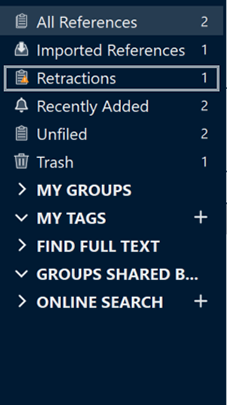
Checking References for Accuracy
Although EndNote captures metadata easily it is always a good idea to check every item's metadata for accuracy; you may need to correct and/or improve it. The quality of the metadata varies with the source of information.
Overview of Adding References into your EndNote Library

There are 5 main methods to add references into your EndNote Library. However, we recommend that you use the Import PDF, Import RIS File and Manual Input methods to add references into your EndNote Library.
We do not recommend using the online search function witjin EndNote as it lack many features and incomplete info. Also many subscribed databases do not integrate with Endnote.
EndNote can import your existing PDF files and automatically generate the citation information so that you do not have to key it in manually.
However, the PDF file needs to have:
If the author, title, journal, etc, fields are not auto-populated, the PDF file is of the wrong format and you will have to do manual entry.
Steps to Import PDF
1. In EndNote, go to File > Import > File or Folder

2. Click on Options, select PDF File or Folder


3. Import PDF files or a folder of PDF.
You can also directly export citation information from the various databases to EndNote directly. However, do note that the full-text will not accompany the citation information.
If you do need the full-text, we recommend that you download the PDF and import the PDF into EndNote directly.
Please also do check the citation information to ensure that it the information is correct and accurate.
Steps to Import RIS File
1. At the database that you are searching, select the records you want
2. Save, output, export or send to EndNote (often labeled as “RIS format”)
3. Go to File -> Import -> File, make sure the Import Option is Reference Manager (RIS) and import the RIS file
4. For PC users, you can also double click on the RIS file and the citations should be imported
Importing RIS File from Scopus
1. Head to Scopus to do your search
2. Select the citations that you want to export out into EndNote

3. Export the citation information as a RIS File

4. Import the RIS File and ensure that the Import Option is Reference Manager (RIS)


Import RIS File from Findmore
1. Head to the NUS Library portal to do your search
2. Select the citations that you want to export out into EndNote

3. Export the citation information as a RIS File

4. Import the RIS File and ensure that the Import Option is Reference Manager (RIS)
Importing .enw File from Google Scholar
Google Scholar uses a different file format as compared to the other databases. Instead of .RIS Files, they use .enw Files. Endnote has the ability to import the .enw File. However, unlike the other databases, you can only import 1 reference at any time.
For PC users, you can try double clicking the .enw Files and Endnote should automatically import the references.
1. Head to Google Scholar to do your search
2. Click on Cite on the article you wish to import and then select EndNote in the pop-up window. A .enw File will be created

3. Import the .enw File and ensure the Import Option is EndNote Import

For all the other database, you can look at this guide. Alternatively, you can contact us if you need further assistance.
This method is used when references cannot be exported out directly to EndNote.
Only very few databases require this method. Some examples of this database include, China Journal Net and Factiva.
For other database that may require this method can be found at this guide.
This method is also useful for people who are trying to merge EndNote Libraries or Mac Users who have issues opening up .RIS files.
For China Journal Net
For Factiva

Do note that for Factiva, the citation information that is imported is usually not clean and it requires users to clean the data. We recommend that for Factiva references, manual input would be the most efficient way to input reference information in your EndNote Library.
Starting from EN20, Retraction Watch database has been integrated. This means that if you have an retracted article in your EN library, it will show up in the left-most column of EN under 'Retractions':

When you click into the item, you will see the retraction details in the right-most panel of EN:

If you have retrieved articles that have been retracted, you would NOT want to cite them or use them in your literature review because they are of dubious quality.
If you want to be alerted to all retractions registered in Retraction Watch in your Endnote library, then please see this post for how to do so.